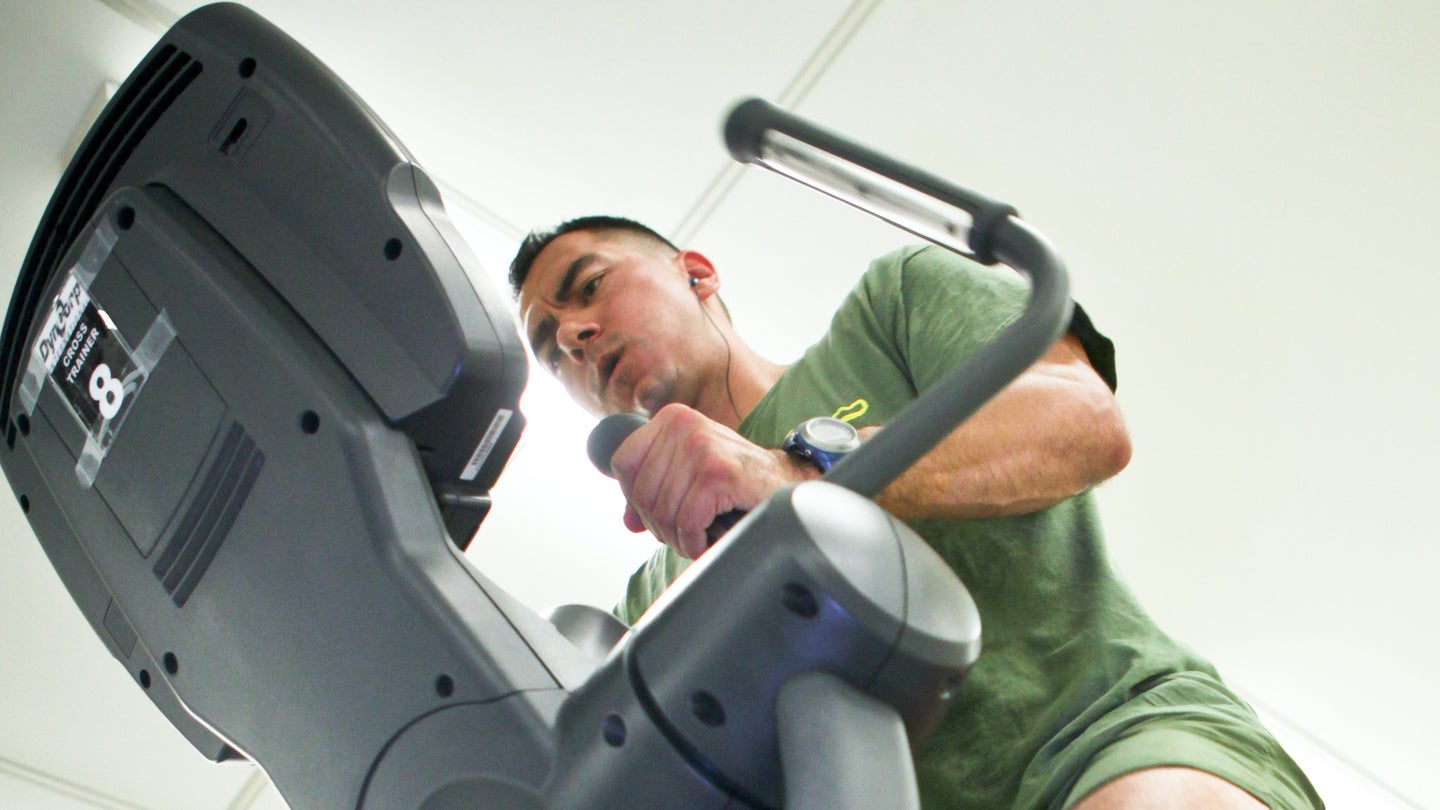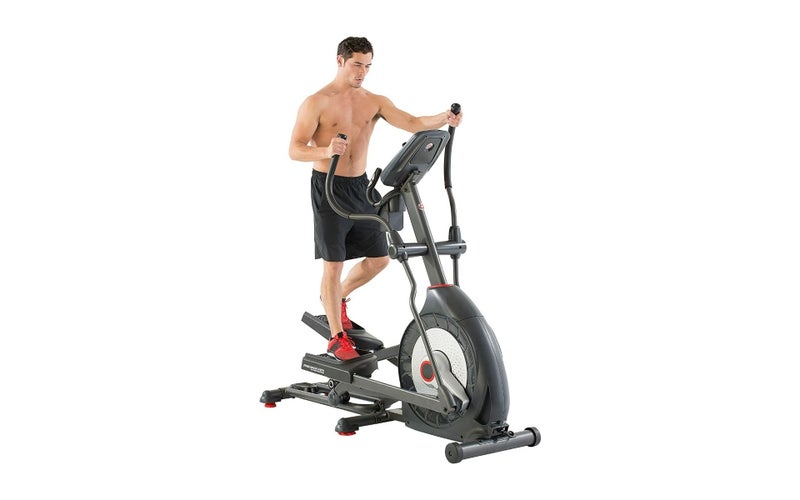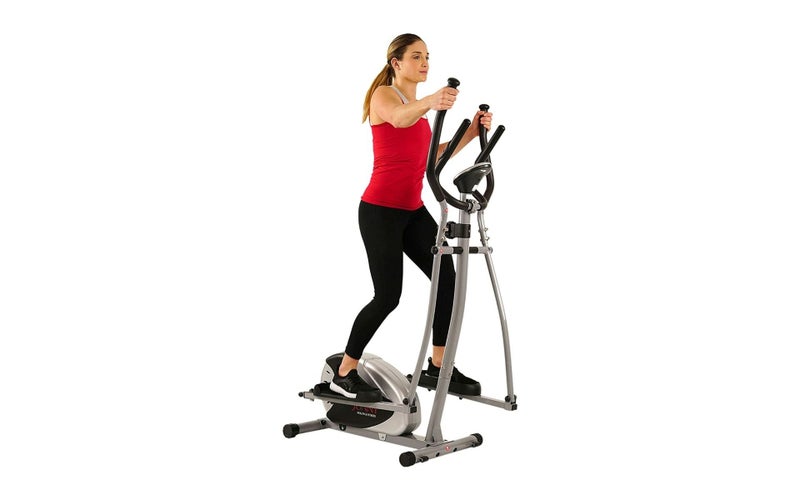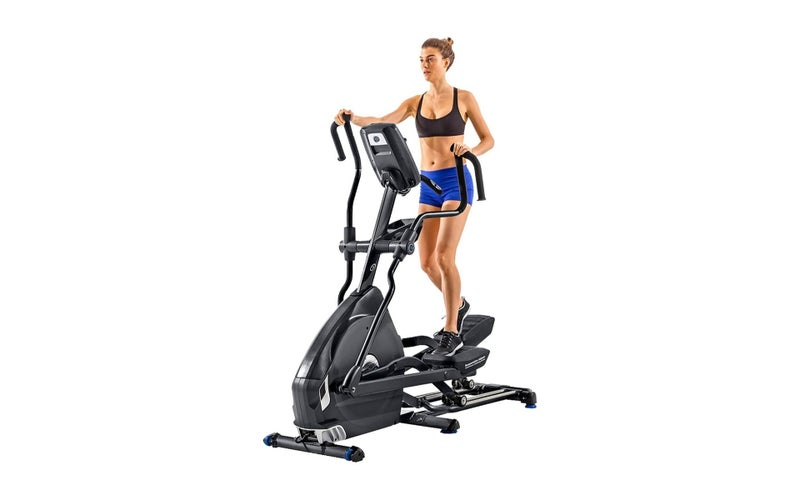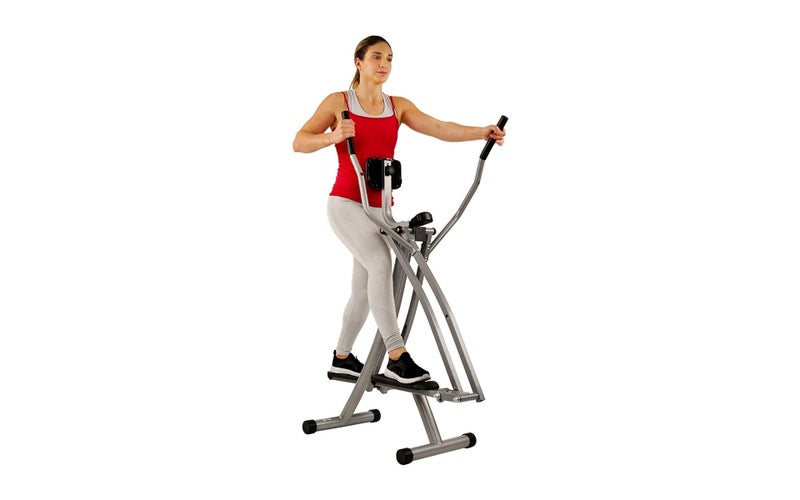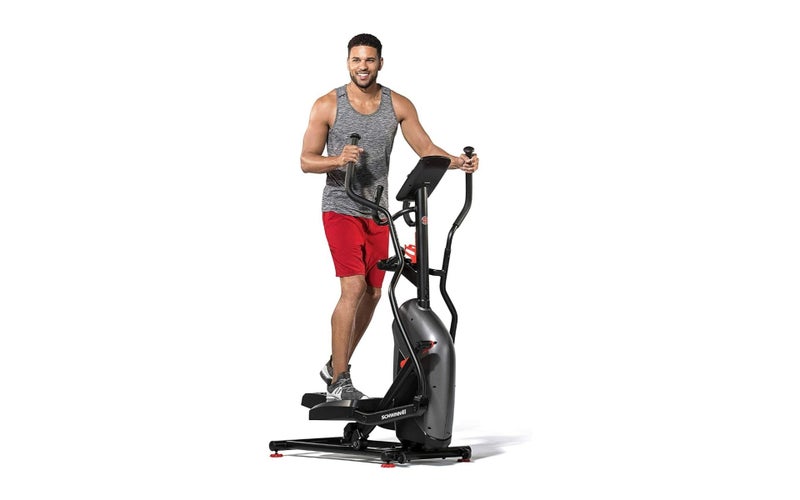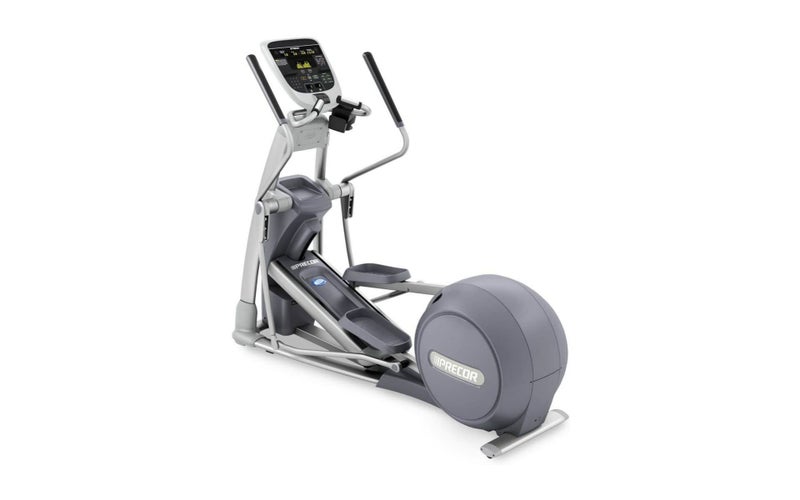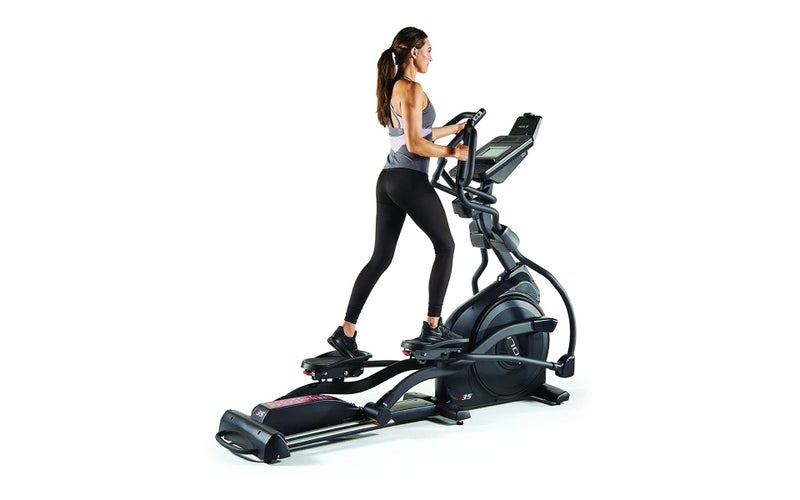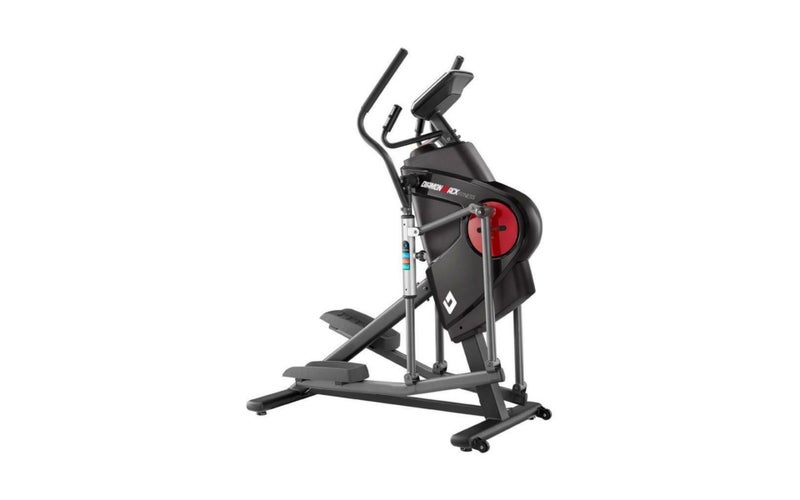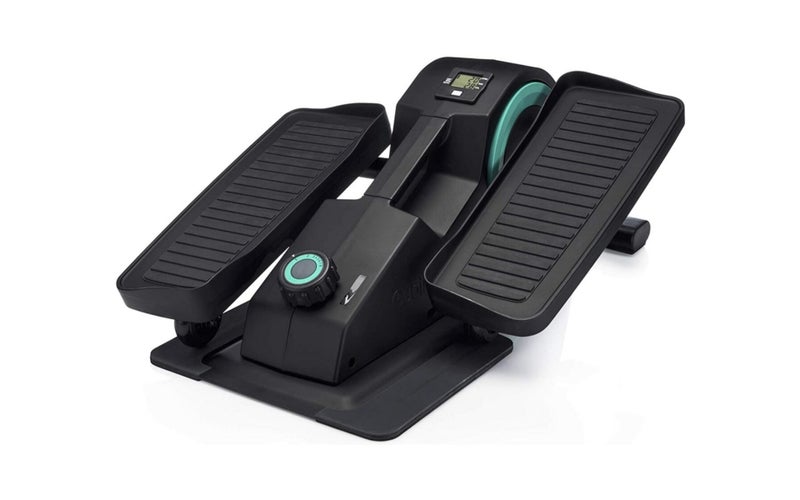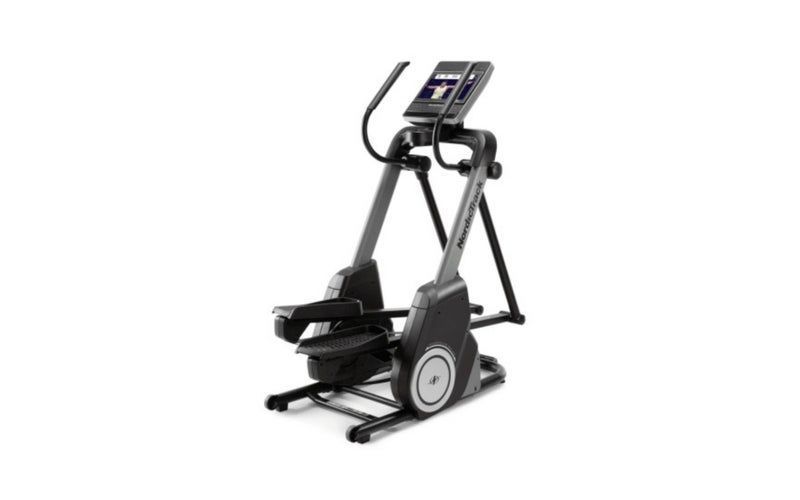We may earn revenue from the products available on this page and participate in affiliate programs.
An elliptical machine is one of the best ways to get a cardio workout without putting a lot of strain on your bones and joints. It’s especially helpful if you’re a runner recovering from a lower-body injury that prevents you from road work. Or, if you don’t want to endure the cold in the winter months and have no time for the gym.
With any new workout gear—and especially higher-cost equipment—you want to make sure you make an informed decision. With that in mind, we’ve put together a list of our top picks for ellipticals on the market right now, along with some educational information to help you make the best possible decision. Read on to find the best ellipticals.
The Schwinn Fitness 470 Elliptical is the overall best and then some. It’s a top-of-the-line elliptical trainer from a well-recognized brand. It offers most of the same features you’d find in ellipticals priced twice as high. This Schwinn elliptical stood out because of its overall performance reviews and versatility in workout options. rnrnWith 29 programmed workouts, 25 levels of eddy current resistance (resistance generated from increased current to an internal electromagnet), and Bluetooth connectivity for syncing with workout apps like MyFitnessPal, Explore The World, and RunSocial, the Schwinn Fitness 470 will keep your workouts fresh and new. The center console has a built-in fan, speakers, USB port, and audio input port, so you should be able to customize your experience however you’d like. rnrnThe Schwinn Fitness 470 is a cross-trainer, so it comes equipped with ergonomically moving handlebars to facilitate a good upper-body workout as well. At 20 inches, the stride length should be comfortable for anyone ranging from 5-foot-4 to 6-foot If you’re short, the machine’s stride might be a bit much and if you’re tall, it might be too choppy. rn
- Dimensions: 63.2 x 28.2 x 70.1 inches
- Stride length: 20 inches
- Weight limit: 300 pounds
29 programmed workouts
25 levels of resistance
Eddy current resistance makes for a quieter ride
Syncs with Bluetooth and fitness tracking apps
Heavy machine, so you won’t want to move it frequently
Occupies a fairly large space
The Sunny Health & Fitness SF-E905 Elliptical gets our best value place for its compact size, range of features, and low price. The SF-E905 is a compact elliptical, making it perfect for folks with a limited amount of space in their home gym. rnrnWith a total length of 28 inches, it shouldn’t be hard to find a spot for this machine and at 68 pounds, it shouldn’t be too difficult to move back and forth to a more advantageous position. The only drawback to the Sunny Health & Fitness SF-905 Elliptical is that, because it’s a compact elliptical, it only carries a stride length of 11 inches, which may be too short for taller users.rnrnAs a cross-trainer, the SF-E905 has full-length moving arm handles, for a smooth upper body workout and two stationary handlebars with pulse reading sensors. The digital display is smaller than some of the pricier ellipticals but allows the user to track speed, distance, time, calories, and pulse, which in my mind is all you need.rn
- Dimensions: 28 x 17 x 57 inches
- Stride length: 11 inches
- Weight limit: 220 pounds
Fits easily in smaller workout spaces
Lighter in weight, making it easier to move
Pulse sensor handlebars
Compact stride length may be awkward for some
Only eight levels of resistance
More basic display settings
The Nautilus E618 Elliptical takes the editor’s choice pick due to two key features. The first is the adjustable foot pedals. If you’ve ever been on an elliptical before, you know that the static placement of your feet can be tough to get used to. Everyone is different and weight distribution on your feet can vary greatly from person to person. This is why the Nautilus E618 Elliptical incorporates adjustable footplates capable of ranging from zero to 10 degrees, allowing the user to change weight distribution and make for a more customized experience. rnrnThe second is the controls. The resistance and incline controls have been integrated into the cross-training handles. Whether on a treadmill, stationary bike, or elliptical, it’s always annoying to have to interrupt the body’s natural movement to adjust a workout setting. With the handle controls of the Nautilus E618, this is no longer a problem and you can customize your workout without having to break your form.rnrnThe Nautilus E618 Elliptical is Bluetooth friendly and allows users to integrate their workouts with various apps, such as Explore The World and others. There are 29 programmed workouts, along with 25 levels of resistance, so there should be something for everyone. Everyone except short people that is. With a 22-inch stride length, the Nautilus E618 may not be comfortable for folks under 5-foot-6.rn
- Dimensions: 73 x 27 x 67 inches
- Stride length: 22 inches
- Weight limit: 350 pounds
Handle-built controls for resistance & incline
10-degree adjustable footplates
29 programmed workouts
Various warranty lengths for various parts
Heavy machine (210 pounds), so it’s not easily movable
Greater length, so it will occupy more space in your gym
It seems that Sunny Health & Fitness is the brand to turn to for budget-friendly ellipticals and they’ve done it once again with the Sunny Health & Fitness SF-E902 Air Walker Trainer. Unlike the other ellipticals in our list, the SF-E902 Air Walker Trainer doesn’t utilize the normal system of belts, flywheels, and magnets you see in most modern elliptical machines. Instead, the SF-E902 utilizes motion derived from the hinges at the middle of the machine for both the pedals and the cross-training handlebars. rnrnSome might see the lack of tech in the SF-E902 as a disadvantage, but I see it as a lot less complicated parts to wear out and break. Plus, without the flywheel and belts, the Air Walker Trainer becomes extremely compact at only 25 inches long, while still allowing a max stride length of 45 inches. The Air Walker Trainer also folds up, to be easily stored out of the way, and at 35 pounds total, it should be a breeze to carry around.rn
- Dimensions: 25 x 19 x 57 inches
- Stride length: 45 inches
- Weight limit: 220 pounds
45-inch max stride length
Foldable for storage in small places
Low maintenance
No adjustable resistance levels
Basic display monitor
Lack of versatility
The Schwinn Fitness 411 Compact Ellipictal is a great choice if you’re looking for all the perks of a larger elliptical, but need to accommodate a smaller workout space. While it’s not small, the Schwinn Fitness 411 Compact Elliptical measures in at 53.8 inches, which is a good foot or two shorter than most other full-size ellipticals. rnrnTypically, when the size of the elliptical goes down, so does the length of the stride (assuming a typical front or rear-drive system), but the Schwinn Fitness 411 Compact Elliptical can maintain a good 18-inch stride length, which is a good middle distance to accommodate most users. rnrnThe Schwinn Fitness 411 Compact Elliptical also features a streamlined center console, capable of syncing with fitness apps, ergonomic moving handles, stationary handles with pulse monitors, and 16 levels of resistance. The Schwinn Fitness 411 Compact Elliptical provides all of this without breaking the bank.rn
- Dimensions: 53.8 x 24 x 62.5 inches
- Stride length: 19 inches
- Weight limit: 300 pounds
Shorter in length than most full-size ellipticals
16 levels of resistance
syncs with fitness apps
Only weights 100 pounds
Not Bluetooth compatible
Smaller display monitor with fewer features
In the 90’s Precor introduced the world to the very first elliptical, with the first of its Elliptical Fitness Crosstrainer (EFX) models and the rest has been history. Precor ellipticals quickly became a staple of fitness centers and gyms worldwide. Not to mention a favorite for physical therapists looking for a low-impact way to improve or maintain their patient’s cardio. I know this because I was one of these patients and I used a Precor model extensively while recovering from knee surgery back in my Army days.rnrnThe Precor EFX 835 is a rear-drive elliptical, making it different than the earlier selections in our list, which are all front-drive machines. While a front-drive system is more of a vertical motion, which can cause jarring on the knees and other joints, Precor’s rear-drive system produces a fluid, horizontal movement taking almost all of the impact out of the exercise. rnrnThe Precor EFX 835 also features Precor’s Cross-ramp Technology, which allows you to target specific lower body muscle groups, simply by raising and lowering the angle of the ramp. The Precor EFX 835 includes 15 programmed workouts and 20 levels of resistance. Unfortunately, if you want a Precor EFX 835 you either need to be a very serious ellipticaller or have some jacked-up knees. rn
- Dimensions: 80 by 32 by 58 inches
- Stride length: 21 inches
- Weight limit: 350 pounds
Low impact and smooth due to rear-drive flywheel
Adjustable cross-ramp technology for targeting muscle groups
15 pre-programmed workouts
Heavy machine (338 pounds) – not easily movable
Expensive
The Sole Fitness E35 Elliptical has all the bases covered to make your workout experience as comfortable as possible. With a 25-pound flywheel (this is pretty heavy for a flywheel and the higher the weight the smoother the ride), the Sole Fitness E35 Elliptical gives a sleek and quiet ride, which is good because you want to be able to hear your music blasting out of the built-in, Bluetooth capable speakers. rnrnThe adjustable incline allows you to focus on specific muscle groups depending on your goals and canted pedals (designed by a physical therapist) ensure there is no additional wear and tear on your ankle joints. Aside from its 10+ programmed workouts, the Sole Fitness E35 Elliptical can sync with fitness apps, so you can customize your experience even more. The rotation of the foot pedals simulates the natural running form, while simultaneously removing all the harmful impact.rnrnThe only downside to the E35 is it’s another big machine and will take up a bit of room in your home gym and at 215 pounds, it will likely be staying put, wherever you place it. But if you have the space, the Sole Fitness E35 Elliptical is a solid choice.rn
- Dimensions: 83 x 27 x 58 inches
- Stride length: 21 inches
- Weight limit: 375 pounds
Adjustable ramp for targeting muscle groups
Canted footplates for maximum comfort
Bluetooth capable, built-in speakers
Built-in, cooling fan
Long elliptical
Heavy machine / not easily moved
Expensive
If you live in an apartment with close neighbors or you’re like me and your family are all still sleeping when you work out, you may want to opt for the quietest elliptical you can find. For that, I present to you the Diamondback 1060EF Adjustable Stride Elliptical Trainer. rnrnDitching the traditional weighted flywheel, the Diamondback 1060EF Adjustable Stride Elliptical employs their Whisper Quiet Magnetic Resistance system, which, as you can imagine, is expected to be whisper quiet by reducing the number of moving parts and friction points inside the machine. rnrnAs the name suggests, the Diamondback 1060EF Adjustable Stride Elliptical Trainer is the first elliptical in our list to have an adjustable stride length. Being able to switch from 18- to 20- to 23-inch stride lengths makes this machine much more versatile for workouts and much more comfortable to use for people of varying heights. rnrnThe Diamondback 1060EF Adjustable Stride Elliptical trainer hits about the middle of the road for price.rn
- Dimensions: 49.2 x 29.5 x 65 inches
- Stride length: Adjustable to 18, 20, or 23 inches
- Weight limit: 300 pounds
Adjustable stride lengths
Whisper quiet magnetic resistance system
Smaller machines take up less space
Less preprogrammed workouts
Smaller display monitor
Don’t have time to work out before work? Then just work out at work. The Cubii JR1 Seated Under Desk Elliptical allows you to do just that. At 27 pounds and under two feet long, the Cubii JR1 is portable and fits easily under most desk spaces, allowing you to pedal away while you crank out those cover sheets for your TPS Reports. rnrnAnd I know what you’re thinking. “Won’t my coworkers think it’s weird?” Yes. They will. But you’ll have the last laugh when your toned legs allow you to outsprint Earl from accounting to get first dibs on the box of donuts Marsha just brought in. At the very least, I’m sure you’ll get mad props from Braydon, the guy who swapped out his desk chair for an obnoxiously colored exercise ball and never looked back.rnrnThe Cubii JR1 Seated Under Desk Elliptical features a magnetic resistance system, which keeps the small machine super quiet and discrete while allowing the user to switch between eight levels of resistance. The Cubii JR1 can be synced to the Cubii App and several other fitness apps and has a small LCD screen for tracking time, distance, calories burned, and rotations per minute. rnrnAll in all, the Cubii JR1 Seated Under Desk Elliptical is a pretty advanced little machine.rn
- Dimensions: 23.15 x 17.56 x 10 inches
- Stride length: Not Specified
- Weight limit: 250 pounds
Portable and quiet
syncs with various fitness tracking apps
Eight levels of resistance
Eliminates excuses
Impractical for high-intensity workouts
Short stride length
You deserve the Nordic Track FS14i. Treat yourself. If you’re looking for a versatile workout machine, this is it. The NordicTrack FS14i is a three-in-one elliptical machine, which allows the user to switch the nature of their leg motion from an elliptical, to a vertical stair stepper, to the horizontal motion of a treadmill. Plus, the machine’s automatic controls allow you to range from a 10-percent incline to a 10-percent decline, making it easy to target different muscle groups and tailor your workouts for specific goals. rnrnThe stride length on the NordicTrack FS14i is fully adjustable and ranges from zero to 32 inches, meaning people of any height can enjoy the machine. And enjoy you will. Especially with a 14-inch HD touchscreen that allows you access to NordicTrack’s iFit Interactive Personal Training, which contains a seemingly endless array of workout options, so you won’t be bored and may forget you’re actually in your laundry room and you think you heard a dog vomit upstairs (drawing from personal experience here).rnrnOne might expect such a flashy elliptical to come with a hefty price tag. One would be right. The NordicTrack FS14i is our Best Splurge choice for a reason.rn
- Dimensions: 58.5 x 29.5 x 74 inches
- Stride length: Adjustable from 0 to 32 inches
- Weight limit: 375 pounds
Adjustable stride length to accommodate users of all heights
Three-in-one workout movements
14-inch HD touchscreen and iFit integration
Automatic control 10 percent incline and decline
Higher price
Heavy machine / not easily moved
Why you should trust us
In June 2008, I had ACL replacement surgery to repair the damage done to my knee during an Army training exercise. As an avid runner, I got the itch to get back on the road fairly quickly, but my physical therapist wouldn’t hear it. As a compromise, I was given the go-ahead to use an elliptical, so I spent the remainder of my summer and fall burning myself out on it.
By the time I was able to get back to running, I had deployed to Afghanistan and it was winter—not the best time or place to start running on a dodgy knee. So I ellipticalled even more, this time facing the bland canvas walls of an Army workout tent. In all, I spent about eight months getting my cardio workouts done on an array of different ellipticals. With that much experience, I feel more than equipped to speak on them.
Types of ellipticals
There are many different types of elliptical machines, but the different types depend on two key factors: the flywheel location and the user’s desired motion. The flywheel can be located at the front, center, or rear of the elliptical and affects the machine’s overall motion, as well as the user’s body position and targeted muscle groups. Within these groups, ellipticals can be broken down further into categories like standard trainers, cross-trainers, gliders, and recumbent.
Front drive
Front-drive ellipticals, as you would expect, position the flywheel at the front of the elliptical. Because of the way the drive belt connects the flywheel to the pedals, the front-drive ellipticals tend to simulate a movement closer to a stair climber machine and keep you lower to the ground than other types. That’s something to consider if your home gym has low ceilings. Front-driver ellipticals are ideal if you’re looking to simulate uphill or climbing workouts. However, you should keep in mind that front-drive ellipticals require more vertical leg movements and therefore can require more out of your knees, which are the problem joints that often send you to an elliptical in the first place.
Rear drive
Rear-drive ellipticals position flywheels at—you guessed it—the rear of the machine. Rear-drive ellipticals are what you’re probably used to seeing in fitness centers. They are the original elliptical design that has been around since the 90’s. The rear-drive machine gives you a longer stride and much less impact on your knees than the front-drive machines. The motion of the rear-drive ellipticals best simulates a normal walking or jogging gait and due to its low impact nature, it seems to be the elliptical of choice if you’re recovering from leg injuries.
Center drive
Center-driver ellipticals are the newest type of elliptical and therefore the least common. The flywheel position is typically off the sides of the machine, sandwiching the pedals in the middle and allowing them to be closer together. It simulates a more realistic running stride. The center-drive elliptical is also thought to be better for your lower back because they don’t require the lean-back of the front-drive machines or the lean-forward of the rear-drive machines. I would bet that this style of elliptical will become more prevalent as time goes on.
Standard trainers
Standard elliptical trainers used to be the most common trainer type. They feature the normal foot pedals, which move in a circular motion but have a stationary bar or handgrips near the display monitor. This means that, with standard elliptical trainers, you are getting almost an entire lower body workout. This also means that there is not a lot of additional movement for your upper body and torso, which makes it one of the lowest impact options available.
Cross-trainers
Cross-trainer ellipticals are similar to standard ellipticals in their pedal placement and leg motion, but cross-trainer ellipticals have moveable arm handles that work in tandem with the motion of the pedals. You can push and pull on the handles as you exercise, to get a workout across your arms, shoulders, and chest, instead of just your lower body. To me, this provides a more natural movement, as most people tend to swing their arms when they run or jog to avoid being mistaken for a robot or pod person.
Gliders
Elliptical gliders tend to look a lot like a standard-trainer elliptical, except that the pedals move back and forth instead of the traditional circular motion of the standard or cross-trainer ellipticals.
Recumbent
A recumbent elliptical allows you to sit while exercising. It looks very similar to a recumbent exercise bike but differs in pedal motion. Recumbent bikes have shorter, faster movements, whereas recumbent ellipticals are longer and slower, reducing the impact on joints. Recumbent ellipticals are a good choice if you’re recovering from injuries, surgeries, or suffering from limited mobility.
Key features of ellipticals
Stride length
The stride length of an elliptical is probably the most important aspect to look at first. Your optimal stride length will be largely dependant on your height and if you don’t choose accordingly, you could end up taking short choppy steps or long, uncomfortable over-strides. The most common stride length in ellipticals is 20 inches, which is generally comfortable for people between heights of 5-foot-4 and 6 feet. If you have people in your home with a big range in height, it may be worth dropping a few extra dollars on a machine with an adjustable stride length.
Resistance levels
It may not be the first thing you think about when looking for an elliptical, but the number of resistance levels your machine offers will affect your satisfaction in the long run. If you are an avid user of your machine, you will likely see gains rather quickly and without the ability to increase resistance, your workouts may plateau and become boring.
More basic models of ellipticals offer few or no levels of resistance, which is fine if you’re not looking to use it all the time or are just using it to maintain a current level of fitness. However, if you are looking to improve your level of fitness, drop some pounds, and reignite your career as a swimsuit model, you’re going to want to step up the difficulty of your workouts every now and again. The more levels of resistance you have, the better workouts you can get.
Display/monitor
Most people like to track their progress when they work out, but there’s a wide degree to which this can be done. For me, there’s a fine line between simply tracking one’s progress and overcomplicating the hell out of it. If you’re someone (like me) who prefers simplicity, you may not mind a machine with a basic display monitor and only a few key tracking data points, such as distance, time, speed, or calories burned. If you like to get into the weeds with numbers and graphs and all that jazz, you may want something a little more swanky that can sync with your other devices, apps, smart appliances, your Alexa, and all the loveable folks at the NSA control center who are cheering you on.
Benefits of ellipticals
Low impact
One of the greatest benefits of an elliptical is that it gives you the great cardio workout of running without all the impact of pounding feet on the pavement. Many people have a hard time with running or jogging, especially later in life, due to the impact it has on ankles, knees, hips, and the lower back. Ellipticals provide a great low-impact alternative and can even be used as a means of rehabilitation from old injuries or recent surgeries. The level of impact can vary by type of elliptical, so if this is a primary reason for purchase, make sure you ensure your final choice fits your body’s needs.
Indoor cardio
Having the means to get a cardio workout indoors can be a lifesaver, especially in the fall and winter, and especially if you live in an area prone to heavy snowfall and low, low temperatures. With a good elliptical, you can avoid the icy roads and potential frostbite on your lungs, while still getting the heart rate up for extended periods.
A quiet workout
Ellipticals tend to be one of the quieter pieces of workout equipment, which is nice if you’re like me and get your daily workout before anyone else in the house is awake. With a treadmill, it’s hard to avoid the tromp, tromp, tromp of your feet slamming down on the belt while you blast away. With an elliptical, you typically get nothing more than a swish, swish, swish and I’ll take a swish over a tromp any day. Keep in mind, the weight of the flywheel in your elliptical can have a large impact on how loud your elliptical is. Typically, a heavier flywheel will make for a smoother, quieter ride.
Pricing Considerations
Budget
In the $0 – $599 price range, you’re looking at more basic models of ellipticals with fewer bells and whistles. Generally, you’ll find front-drive machines with smaller display monitors, but this is a great price range to look at when trying to find something compact for a home gym with limited space. Just be careful and make sure you check the stride length on the machines in this category. Small or “compact” ellipticals can sometimes have a smaller stride length.
Mid-range
The $600 – $1,999 price range is where you’ll start to get a lot more versatility in your elliptical. Generally in this category, the display monitors improve dramatically, and there are a wide range of programmed workouts already loaded into the elliptical. You’ll usually see an increase in the number of resistance levels, as well as the quality of the internal electromagnets which help control resistance and make the ride smoother and quieter. Ellipticals in this category tend to be on the longer side, so most will require a decent amount of space in your home gym.
Premium
When you get above $2000, then you start getting into the big guys. Ellipticals in this category are on par with ones found in fitness centers, resort gyms, and physical therapist’s offices. Most of the machines in this category are rear-drive machines and will be quite large and heavy. That being said, you’ll likely get what you pay for and if you plan to be an avid elliptical rider or you know you’re prone to joint or back injuries, it could be worth dropping the extra coin to get the smoothest ride possible.
How we chose our top picks
Our list of top picks was derived from a ton of research on ellipticals, as well as an abundance of personal experience. I scoured ranking lists, individual product reviews, and Amazon item reviews to find the hot models that are all the rage in the dynamic world of ellipticals. I also drew from my own experiences recovering from knee surgery and reflected on the features I enjoyed and those I didn’t. With all this information and considering the various price points, I’m confident I’ve put together a quality list you can use to build your knowledge before buying your own elliptical.
FAQs on ellipticals
Q. Should I go with a front drive or rear drive elliptical
A: This depends on your workout goals. Front-drive machines tend to offer more of a “stair-stepper” motion and can be useful when training for uphill hikes and climbing. Rear-drive ellipticals tend to have a flatter, horizontal movement that mimics standard walks or runs.
Q. Should I buy an elliptical with a heavier flywheel?
A: If you can, yes. The heavier the flywheel, the smoother and quieter the ride will be, but keep in mind, as the flywheel size increase, the price typically does too. Also, don’t get too hung up on the flywheel. There are some quality machines out there that don’t even use a flywheel.
Q. Why is stride length important?
A: Stride length will determine how comfortable you are on the elliptical. If the stride length is too short, your experience will feel choppy and awkward. If it’s too long, you may struggle and over-extend. Make sure you pick a stride length appropriate for your height.
Q. What is the best type of resistance system?
A: The eddy current resistance system is the most common in higher-end machines. The eddy current resistance system works by moving an electromagnet closer or farther away from the flywheel to change the resistance respectively. Because it is controlled via electric current, there are fewer moving parts and therefore fewer opportunities for performance issues.
Q. What is an elliptical crosstrainer?
A: Elliptical cross trainers are machines that have ergonomically moving arm handles that allow the user to get an upper-body workout also.
Our gear section
Brett Allen is a humor writer and former U.S. Army cavalry officer who served from 2006 to 2010, largely with the 3rd Squadron, 71st Cavalry Regiment of the 10th Mountain Division. The events of his 2009 deployment to the Logar Province of Afghanistan became the inspiration for his recently published debut novel, Kilroy Was Here, which is a dark comedy highlighting the absurdities of war. Brett resides in Ada, Michigan with his wife and kids and is currently working on his next novel. He enjoys all things outdoors to include backwoods camping, backwoods cooking, hiking, and boating, but can more regularly be found mowing, weed whacking, or performing some other form of backbreaking yardwork.
